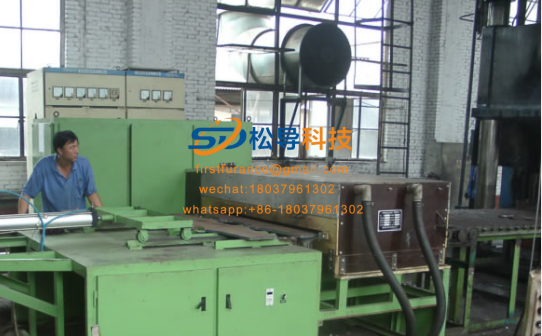A, on-site water requirements:
1. Spray water requirements:
Water flow: ≥20 cubic meters / hour (single water supply)
Water pressure: 0.5~0.8MPa
2. Quenching sensor water requirements: (single) (single water supply)
Water flow: ≥20 cubic meters / hour
Water pressure: ≥0.5MPa
3. Requirements for insulation induction furnace water: (single water supply)
Water flow: ≥8 cubic meters / hour
Water pressure: 0.2 to 0.3 MPa
4. IF power supply requirements:
Water flow: ≥10 cubic meters / hour
Water pressure: 0.2 to 0.3 MPa

B, compressed air requirements:
Working pressure: ≥0.4MPa, hourly dosage: ≥3 cubic
Total power supply:
Single set of equipment IF power supply 400Kw × 2+160KW
Additional equipment (drive motor) 10Kw
C. Brief description of the work process:
This set of equipment is mainly for induction heating quenching equipment of 10#~22# single ball flat steel and symmetrical ball flat steel. The production capacity is 1646# symmetric ball flat steel as an example, the output is more than 1.5 tons/hour.
Firstly, the ball flat steel which has been qualified by rolling is directly lifted by the crane to the chain feeder, and then manually intervened, placed in order, conveyed to the end by the chain conveyor, and blocked by the blocking mechanism. There is a proximity switch detection, and when the material is detected, the chain conveyor stops working). At the same time, the pneumatic reclaiming device starts to work, the cylinder piston rod drives the electric disk to drop above the workpiece, and sucks the material (the lifting cylinder is 2-φ160×200). After the cylinder rises into position, the translation cylinder works (the translation cylinder is 2-φ160). ×1000), the workpiece is translated to the top of the raceway, after the lift cylinder is lowered into position, the power of the electric disk is turned off, and the workpiece is placed on the feed conveying raceway.
The entire set of equipment is evenly distributed with 10 wheels to prevent the ball flat steel from turning over due to the weight of the head. The workpiece is hung on the conveying raceway, and the cylinder of the adjusting wheel is operated. After the material is adjusted according to the size of the material, the adjusting wheel is retracted. During the advancement process, the workpiece enters the first group of pressure roller mechanisms. (To prevent the material from slipping, the pressure roller mechanism of this group adopts a rubber pressure roller), and a materialless detection switch is arranged at 850 mm in front of the rubber pressure roller. After that, the signal is sent and the electric disk is loaded again. In order to prevent deformation of the workpiece, a set of adjustment wheels and two sets of support wheels are arranged before entering the quenching induction coil. When the material enters the second group of pressure roller mechanisms, the first intermediate frequency power supply is started, the coil starts to heat, and the heating temperature is about 700 °C. When the material advances into the third group of pressure roller mechanism, the second intermediate frequency power supply is started, and the coil starts to heat the material, and the heating temperature is 930 to 950 °C. There are two sets of infrared thermometers, one for measuring the web temperature and the other for measuring the ball temperature. (The quenching heating is equipped with two sets of 400Kw/6KHz intermediate frequency power supply) The workpiece continues to advance and enters the induction induction furnace. The insulation adopts medium frequency insulation, and the supporting power supply is 160Kw/500Hz. There are also two sets of infrared thermometers, one for measuring the web temperature and the other for measuring the ball temperature. After the heat preservation, the spray is sprayed, and the spray pump should be equipped with a booster pump so that the pressure of the spray water is between 0.5 and 0.8 MPa, and the flow rate is ≥ 20 cubic meters per hour. After spraying, it enters the fourth group of pressure roller mechanism, and then enters the discharge conveying roller. When the material detecting switch detects the material head, the frequency converter speeds up and discharges quickly. When the tail end detecting switch detects the tail, it turns over. The cylinder starts to work (2-φ160×275), and the material is turned into the collecting material rack.

